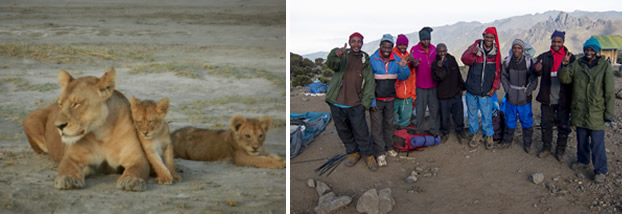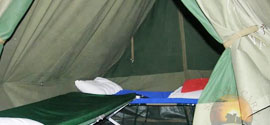13 days Safari and Trekking Kilimanjaro

Day One: Lake Manyara National Park
Leave Arusha after breakfast for an all day game drive in Lake Manyara National Park. Lake Manyara, a Rift Valley chain lake, is nestled at the foot of a spectacular 2,000-foot escarpment and is surrounded by a lush tropical forest filled with towering mahogany and fig trees. During the game drive, visit the park's five different vegetation zones and spend time at the lakeshore viewing magnificent birds. Encounter baboon, giraffe, hippopotamus, elephant, and buffalo. If lucky, you may glimpse Manyara's famous tree-climbing lions.
Overnight at Panorama Campsite. The private campsite overlooks Lake Manyara National Park and the Rift Valley. You will have your own private canvas tent. The site has several sitting areas, showers and bathrooms, a bar, and kitchen.
Day Two: Serengeti National Park
After breakfast drive to Serengeti National Park for an all day game drive. Chat with Maasai herdsmen along the way and eat a picnic lunch. Serengeti National Park, which has been declared a World Heritage Site and Biosphere Reserve, is a vast and beautiful expanse of 5,600 square miles, and supports the largest concentration of plain game in the world. Famous for its gregarious procession of millions of wildebeest and zebra that takes place from December to August, the Serengeti attracts thousands of visitors each year.
The migration offers excellent opportunities to view animal behavior due to the abundance of both predators and prey. Common animals are wildebeest, cheetah, zebra, lion, giraffe, and many antelopes.
Drive across the Seronera Plain to the northwest gate of the Serengeti. You will arrive at Ikoma Bush Camp at around 6pm. Ikoma Bush Camp is a remote campsite set in an acacia grove three kilometers from Ikoma Gate. It is extremely private and you will have a chance to explore the more remote areas of the Serengeti on your own.
Day Three: Serengeti National Park
Spend all of day three in Serengeti National Park viewing animals such as hippo, cape buffalo, giraffe, cheetah and lion. The Serengeti region encompasses Serengeti National Park itself, the Ngorongoro Conservation Area, Maswa Game Reserve, the Loliondo, Grumeti and Ikorongo Controlled Areas and the Maasai Mara National Reserve in Kenya. Journey to pools and less well-traveled areas of the Serengeti. Return to camp for a hot lunch, relax for a little while, and then continue on with another game drive in the afternoon. Return to Ikoma Bush Camp for dinner and overnight.
Day Four: Serengeti to Ngorongoro
After an early breakfast, drive to Grumet River to spend time watching bird and water life. We will have the opportunity to view crocodiles and may be lucky enough to see a crocodile hunt a wildebeest. Continue on a game drive close to the river and then return to the campsite for a hot lunch.
After lunch drive to Ngorongoro Crater. Well make sure to get you to the crater rim Simba Campsite in time for the spectacular sunset. Simba Campsite overlooks the crater and offers breathtaking views. Spot animals on the crater floor from the campsite. Be sure to bring warm clothes for this night as the crater rim may be very cold.
Day Five: Ngorongoro Crater
A full day in the world-renowned Ngorongoro Crater awaits. After descending 2000 feet to the crater floor, view the various resident animals on the crater floor. The largest unbroken caldera in the world, Ngorongoro has an area of 260 kilometers and a depth of 610 meters.
The crater provides a protected habitat for thousands of mammals and birds. The entire day is spent on the crater floor viewing lion, hyena, wildebeest, zebra, black rhinoceros, and many species of small antelopes. During some seasons, the soda lake on the crater floor is crowded with flamingo and other water birds. You may also see Maasai herdsmen grazing their cattle in the crater.
Enjoy your picnic lunch on the crater floor where Black Kites feed on tourists' leftovers. Lunch offers an excellent opportunity to view the behavior of birds and observe the forest elephants that usually feed in the marsh near the picnic area. After lunch, continue on a game drive to spot the most elusive members of the Big Five, rhinoceros and leopard. Overnight at Simba Campsite.
Day Six: Tarangire National Park
After breakfast, drive to Tarangire to discover the giant termite mounds and baobab trees of Tarangire. This park, which is home to thousands of elephant, sports a particularly dense wildlife population between June and October. In the dry season, game congregates along the river having migrated from the Maasai Mara. The vegetation of this park consists of open acacia woodland dotted with many baobab trees. Tarangire is an ornithologists paradise, offering an incredible diversity of avifauna. Overnight at Tarangire Campsite, enjoying the privacy of the secluded camp.
Day Seven: Tarangire National Park to Moshi
Spend day seven in Tarangire following elephants and lions. Leave the park in the afternoon for Moshi. On day seven, get a full night of rest at the new Keys Hotel in Moshi to prepare for your Kilimanjaro climb.
Kilimanjaro: Day Eight: Machame Gate (1,800m) to Machame Camp (3,000m)
Elevation Gain: 1,200 meters
Hiking Time: 5 to 6 hours
Distance: 10 kilometers
After an early breakfast in Moshi, proceed to Machame Gate where you will meet the Duma Explorer porters, guides, and cooks that will spend the next six days trekking with you to Uhuru Peak, the roof of Africa. The drive through coffee farms and villages to Machame Gate takes just under an hour. The road is paved for most of the way with the last fifteen minutes on a 4WD track. Once you arrive, you'll spend about an hour waiting at the gate while
Safari Care Ltdr egisters your climb and the porters and guides make final preparations.
At around 10am, you will begin hiking with your guides to Machame Camp, the destination for your first day of hiking. The porters and cooks walk ahead of the group to set up the camp in time for your arrival. For the first three kilometers you'll hike along a 4WD track that passes through the moss-covered trees of Kilimanjaro's cloud forest. You will then reach a signpost that marks the beginning of the mountain trail and the end of the 4WD track. The narrow trail is steeper and more slippery than the 4WD track and you will want to have your walking sticks with you. Continue on through the cloud forest for another 1.5 hours until you reach a clearing where you will break and eat lunch.
After lunch, you will hike through the cloud forest for another hour before leaving the forest for the scrubland. As the forest thins, the vegetation will change to include heathers, tall grasses and many species of wildflowers. If the weather is clear you will also be able to see some views of the surrounding area and your ultimate destination, Kibo Peak. Continue on for another half an hour before reaching Machame Camp for hot tea and snacks.
Day Nine: Machame Camp (3,000m) to Shira Camp (3,840m)
Elevation Gain: 840 meters
Hiking Time: 5-6 hours
Distance: 7 kilometers
Although considered to be the easiest day on the Machame Route, the route includes several strenuous uphill sections. You will be walking through exposed heather and moorland. Carry plenty of drinking water, as the hike can be quite hot on a clear day. During this section of the trail there are several viewpoints from which you can see the plains and forests below and Kibo and Mawenzi peaks above. As you gain altitude, the vegetation changes: The trees diminish in size, giving way to Kilimanjaro's famous high altitude plants, Scenecio kilimanjari and Lobelia deckenii. After eating lunch, you will climb the Shira Plateau, created when Kibo's lava flows filled up the Shira crater. Continue for another thirty minutes to Shira Camp, where you will relax for the rest of the day.
Day Ten: Shira Camp (3,840m) to Barranco Camp (3,950m)
Elevation Gain: 690 meters
Elevation Loss: 580 meters
Hiking Time: 5 to 6 hours
Distance: 10 kilometers
Although this up and down day ends with an elevation gain of only 110 meters, by early afternoon you will have climbed 690 meters to a height of 4,530 meters before beginning your descent to Barranco Camp. Although the route is somewhat frustrating, this day is crucial for acclimatization.
After breakfast, continue east on the Shira Plateau for two hours before reaching the junction for Shira and Lemosho Routes. Continue on through the barren landscape for another half an hour before stopping for lunch. Shortly after lunch you will reach the highest point of the day before descending quickly to Barranco Camp. From the high point, you can see Lava Tower, a 300-foot lava formation jutting out of the mountainside. Barranco Camp is considered to be the most scenic campsite on the Machame Route. From the campsite you will see magnificent views of Mount Meru, Heim Glacier and Kibo's southern face.
Day Eleven: Barranco Camp (3,950m) to Barafu Camp (4,550m)
Elevation Gain: 600 meters
Hiking Time: 7 to 8 hours
Distance: 8 Kilometers
Leave Barranco Hut after an early breakfast to begin the long hike to Barafu Camp. The day begins with an hour and a half scramble up the Barranco Wall. This is the hardest part of the day and in some places you will have to use your hands to pull your body up. After reaching the top, you will make a short descent into the greener Karanga Valley before continuing on to Barafu Camp. On the way to Barafu you will see several of Kibo's glaciers as well as the junction that connects our descent route, the Mweka trail, with the Machame trail. During day four you will hike by the Heim, Kersten and Decken Glaciers. Although the way to Barafu is bleak, alpine desert with little vegetation, Barafu Camp offers stunning views of Kibo and Mawenzi peaks, and Rebmann Glacier. Try to sleep as soon as you finish dinner as you will be waking up at midnight for your summit hike.
Day Twelve: Barafu Camp (4,550m) to Uhuru Peak (5,895m) to Mweka Camp (3,100m)
Elevation Gain: 1,345 meters
Elevation Loss: 2,795 meters
Hiking Time: 11-12 hours
Distance: 18 kilometers
At midnight you will begin your ascent to Uhuru Peak, the highest point in Africa. For the next six hours, you will hike by flashlight. It is helpful to use a headlamp so your arms are free during the ascent. The Machame ascent to the crater rim is the most challenging part of the entire six-day trek. For much of the hike you will walk on a gravel slope that causes you to slip back slightly with every step forward. The going is extremely slow until you reach the crater rim at Stella Point.
The hike from Stella Point to Uhuru Peak is a gradual climb and, as far as hikes go, not very difficult. The altitude, however, makes the hike a psychological battle, and you will need to go very slowly to reach the top. The guide will advise you on how to make the hike easier. The crater rim hike takes about forty-five minutes and you should reach Uhuru Peak around sunrise. Take photos of your guide and group at the peak before beginning the long descent to Mweka Camp. On the way down from Uhuru you will enjoy breathtaking views of the mountain, crater, glaciers and Tanzania. If it is a cloudy day, you will still have the luxury of the gorgeous views of the clouds below. At Barafu Camp, eat breakfast, drink lots of tea and take a short break. You still have another three hours to go before reaching Mweka Camp, day five's destination.
Day Thirteen: Mweka Camp (3,100m) to Mweka Gate (1,500m)
Elevation Loss: 1,600 meters
Hiking Time: 2 to 3 hours
Distance: 10 kilometers
After breakfast you'll finish the trek with a descent to Mweka Gate. Your last hike on Kilimanjaro is a beautiful one, passing through the enormous trees of the cloud forest. Watch your step during the descent, as the trail can be extremely slippery. Duma Explorer Land Rovers will be waiting at the lower station of Mweka Gate to take you back to Moshi. You will be able to buy t-shirts and sodas at the gate.




